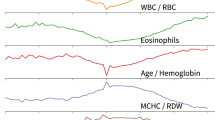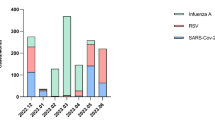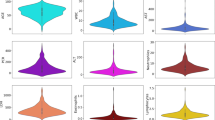Abstract
The current gold standard for SARS-CoV-2 detection methods lacks the functionality to perform population screening. Complete blood count (CBC) tests are a cost-effective way to reach a wide range of people – e.g. according to the data of the Central Statistical Office of Poland from 2016, there are 3,000 blood diagnostic laboratories in Poland, and 46% of Polish people have at least one CBC test per year. In our work, we show the possibility of machine detection of SARS-CoV-2 virus on the basis of routine blood tests. The role of the model is to facilitate the screening of SARS-CoV-2 in asymptomatic patients or in the incubation phase. Early research suggests that asymptomatic patients with COVID-19 may develop complications of COVID-19 (e.g., a type of lung injury). The solution we propose has an F1 score of 87.37%. We show the difference in the results obtained on Polish and Italian data sets, challenges in cross-country knowledge transfer and the selection of machine learning algorithms. We also show that CBC-based models can be a convenient, cost-effective and accurate method for the detection of SARS-CoV-2, however, such a model requires validation on an external cohort before being put into clinical practice.
Access this chapter
Tax calculation will be finalised at checkout
Purchases are for personal use only
Similar content being viewed by others
References
Python package index, xgboost. https://pypi.org/project/xgboost/. Accessed 29 Oct 2021
Coronahack - Chest X-Ray-Dataset (2020). https://www.kaggle.com/praveengovi/coronahack-chest-xraydataset?select=Chest_xray_Corona_Metadata.csv. Accessed 29 Oct 2021
COVID-19 dataset collected by Societa Italiana di Radiologia Medica e Interventistica (2020). https://sirm.org/category/covid-19/. Accessed 29 Oct 2021
COVID-19 dataset made available by a twitter user (2020). https://twitter.com/ChestImaging/status/1243928581983670272. Accessed 29 Oct 2021
Arık, S.O., Pfister, T.: Tabnet: attentive interpretable tabular learning. In: AAAI, vol. 35, pp. 6679–6687 (2021)
Bernheim, A., et al.: Chest CT findings in coronavirus disease-19 (COVID-19): relationship to duration of infection. Radiology 200463 (2020)
Cabitza, F., et al.: Development, evaluation, and validation of machine learning models for COVID-19 detection based on routine blood tests. Clin. Chem. Lab. Med. (CCLM) 59(2), 421–431 (2021)
Cohen, J.P., Morrison, P., Dao, L., Roth, K., Duong, T.Q., Ghassemi, M.: COVID-19 image data collection: prospective predictions are the future. arXiv preprint arXiv:2006.11988 (2020)
Das, A.K., Ghosh, S., Thunder, S., Dutta, R., Agarwal, S., Chakrabarti, A.: Automatic COVID-19 detection from X-ray images using ensemble learning with convolutional neural network. Pattern Anal. Appl. 24(3), 1111–1124 (2021). https://doi.org/10.1007/s10044-021-00970-4
French, G., Mackiewicz, M., Fisher, M.: Self-ensembling for visual domain adaptation. arXiv preprint arXiv:1706.05208 (2017)
He, K., Zhang, X., Ren, S., Sun, J.: Deep residual learning for image recognition. In: Proceedings of the IEEE Conference on Computer Vision and Pattern Recognition, pp. 770–778 (2016)
Jaderberg, M., Simonyan, K., Zisserman, A., Kavukcuoglu, K.: Spatial transformer networks. In: Advances in Neural Information Processing Systems, vol. 28, pp. 2017–2025 (2015)
Klaudel, B., Obuchowski, A., Karski, R., Rydziński, B., Jasik, P., Kowalczuk, Z.: COVID-19 severity forecast based on machine learning and complete blood count data. In: 2022 15th International Conference on Diagnostics of Processes and Systems (DPS), Chmielno/Gdańsk (Poland) (2022, submitted)
Kukar, M., et al.: COVID-19 diagnosis by routine blood tests using machine learning. Sci. Rep. 11(1), 1–9 (2021)
Long, Q.X., et al.: Clinical and immunological assessment of asymptomatic SARS-CoV-2 infections. Nat. Med. 26(8), 1200–1204 (2020)
Morozov, S., et al.: MosMedData: chest CT scans with COVID-19 related findings dataset. arXiv preprint arXiv:2005.06465 (2020)
Poggiali, E., et al.: Can lung US help critical care clinicians in the early diagnosis of novel coronavirus (COVID-19) pneumonia? Radiology 295(3), E6–E6 (2020)
Prokhorenkova, L., Gusev, G., Vorobev, A., Dorogush, A.V., Gulin, A.: CatBoost: unbiased boosting with categorical features. arXiv preprint arXiv:1706.09516 (2017)
Prokop, M., et al.: CO-RADS: a categorical CT assessment scheme for patients suspected of having COVID-19 - definition and evaluation. Radiology 296(2), E97–E104 (2020)
Roy, S., et al.: Deep learning for classification and localization of COVID-19 markers in point-of-care lung ultrasound. IEEE Trans. Med. Imaging 39(8), 2676–2687 (2020)
Soares, F.: A novel specific artificial intelligence-based method to identify COVID-19 cases using simple blood exams. MedRxiv (2020)
Soltan, A.A., et al.: Artificial intelligence driven assessment of routinely collected healthcare data is an effective screening test for COVID-19 in patients presenting to hospital. MedRxiv (2020)
Syeda, H.B., et al.: Role of machine learning techniques to tackle the COVID-19 crisis: Systematic review. JMIR Med. Inform. 9(1), e23811 (2021)
WHO: WHO coronavirus (COVID-19) dashboard. https://covid19.who.int/
Wong, M.D., Thai, T., Li, Y., Liu, H.: The role of chest computed tomography in the management of COVID-19: a review of results and recommendations. Exp. Biol. Med. 245(13), 1096–1103 (2020)
Wu, J., et al.: Rapid and accurate identification of COVID-19 infection through machine learning based on clinical available blood test results. MedRxiv (2020)
Zhao, W., Jiang, W., Qiu, X.: Deep learning for COVID-19 detection based on CT images. Sci. Rep. 11(1), 1–12 (2021)
Author information
Authors and Affiliations
Corresponding author
Editor information
Editors and Affiliations
Rights and permissions
Copyright information
© 2023 The Author(s), under exclusive license to Springer Nature Switzerland AG
About this paper
Cite this paper
Klaudel, B., Obuchowski, A., Dąbrowska, M., Sałaga-Zaleska, K., Kowalczuk, Z. (2023). Machine-Aided Detection of SARS-CoV-2 from Complete Blood Count. In: Kowalczuk, Z. (eds) Intelligent and Safe Computer Systems in Control and Diagnostics. DPS 2022. Lecture Notes in Networks and Systems, vol 545. Springer, Cham. https://doi.org/10.1007/978-3-031-16159-9_2
Download citation
DOI: https://doi.org/10.1007/978-3-031-16159-9_2
Published:
Publisher Name: Springer, Cham
Print ISBN: 978-3-031-16158-2
Online ISBN: 978-3-031-16159-9
eBook Packages: Intelligent Technologies and RoboticsIntelligent Technologies and Robotics (R0)




